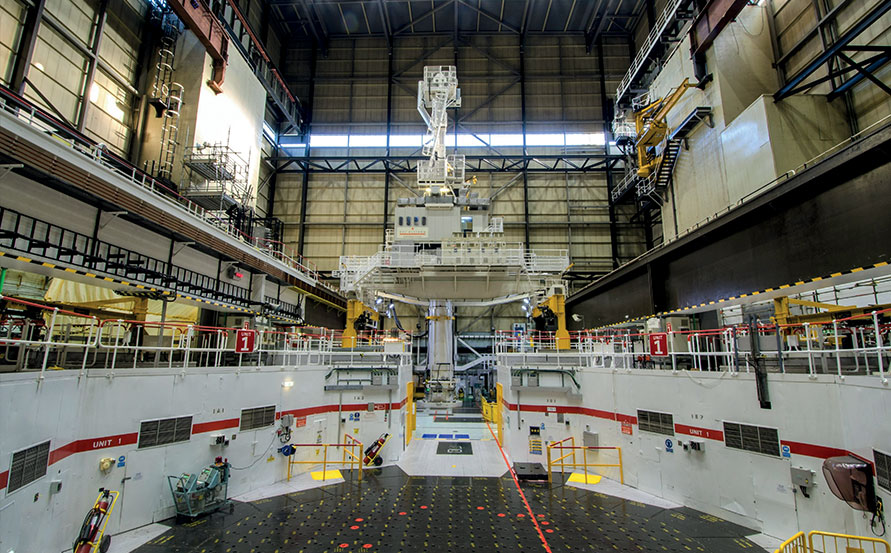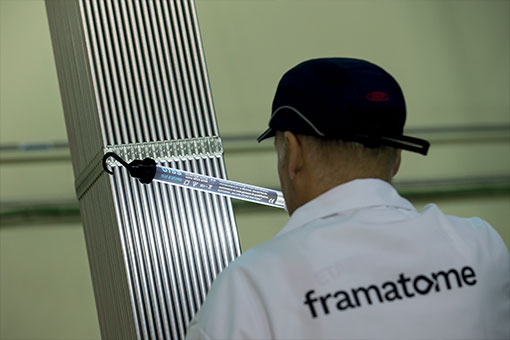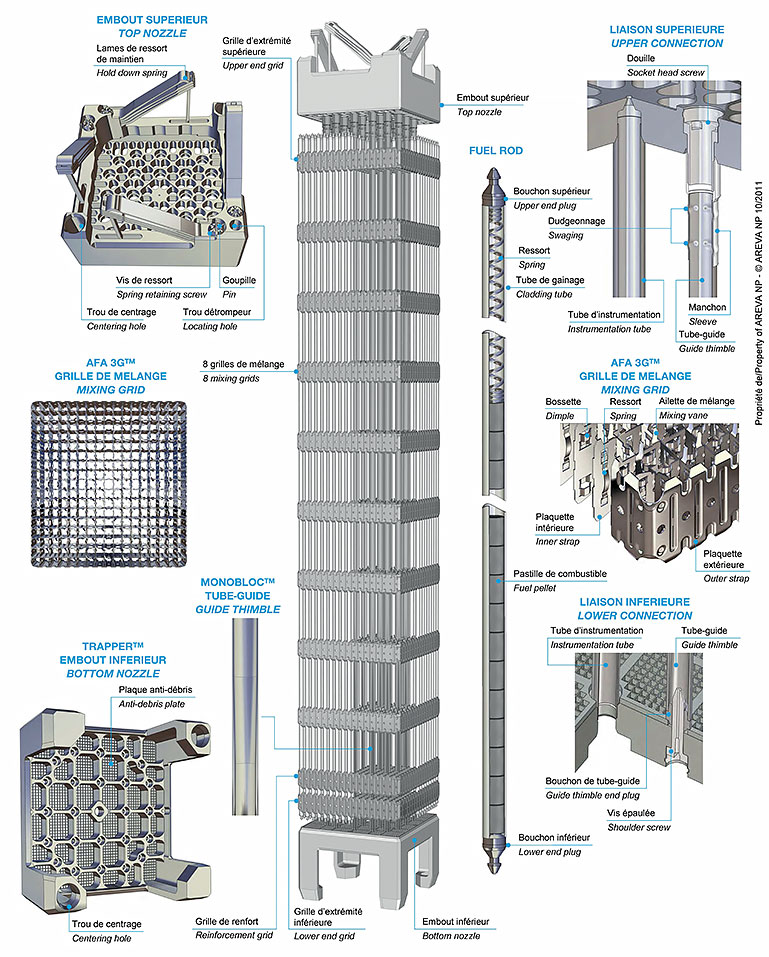- Home
- Foreword
- Contents
- 1. Retrospective and perspectives
- 2. At the heart of safety: high standards and leadership
- 3. Industrial safety and radiological protection: it’s behaviours that count
- 4. Pragmatism for the EPR2
- 5. The fleet upgrade: a colossal programme
- 6. Reactors that adapt to climate change
- 7. Nuclear fuel and reactivity control: the heart of nuclear safety
- 8. Competences: are we sufficiently demanding?
- 9. Changes in the electricity system: anticipate rather than suffer
- Appendices
- Contact
Navigation
Navigation
INTRODUCTION
Nuclear fuel is an area of sophisticated technology and excellence.
Whether in operations or engineering, reactivity management is the primary nuclear safety function.
Over the years, technological issues have been resolved and nuclear fuel has gained significant safety margins.
Fuel handling equipment is experiencing reliability and obsolescence problems.
The place where fission occurs and the power density is concentrated, nuclear fuel represents the heart of a reactor. Its design, manufacturing and operation requires a high level of expertise.
REACTIVITY CONTROL: THE NUCLEUS OF OUR INDUSTRY
As the fission chain reaction is the nucleus of our industry and its energy potential is formidable, managing reactivity is the first nuclear safety function.
Focus on reactivity management has increased in the past two years. In France, the core and fuel engineers (IECC) manage the improvement plans at the plants. Incidents nevertheless occur, and it is necessary to maintain the work with competence and rigour. For instance, I believe that all dilution and manual control rod handling operations should be subject to monitoring, three-way communications or systematically peer-checked, as I have observed in the UK. Incidents in France and the UK also serve as a reminder of the need for strict control of boron concentrations and sources of pure or cold water when the reactor is shut down.
Boration incident
The control room operator injected boron into the primary system. He did not sufficiently push down the stop button on the control panel, and in around six minutes 1100 litres of boron, instead of 30 litres, was injected. Realising that too much boron had been injected, the operator started a ‘reflexive’ dilution without any prior calculations and on his own. The reactor power dropped from 8.5% to 0.07% of its nominal power.
In the UK, the Nuclear Safety Group (NSG) is strong and works closely with the control room teams. Refuelling at the Torness and Heysham 2 plants now happens with the reactors shut down and depressurised, instead of on-load, which changes how the core is controlled because its reactivity is higher after batch refuelling. Performance indicators and the committees for reactivity management have not changed for several years, and Nuclear Operations is reviewing the situation in search of greater effectiveness: I will be following this initiative closely as certain events require feedback.
Exploring avenues of progress must also be an engineering goal. Being able to cool the reactor after an automatic trip without risking it going critical again, even in the absence of a boron injection, would contribute to a higher level of intrinsic nuclear safety. In this context, the actual behaviour of the reactor could be assessed by removing conservatisms. Following the advances made in the last twenty years, it would also be pertinent to further explore methods to prevent the risk of injecting water plugs into the core, e.g., a slow start-up of the primary pumps.
AN AREA OF SOPHISTICATED TECHNOLOGY AND EXCELLENCE
Nuclear fuel must withstand hydraulic, thermal and mechanical loads during normal operation and accident conditions. Behaviour of the fuel cladding is the focus of studies in the fields of physics, materials and accidents.

A firmly established network of expertise
I met with the Group’s main players in the nuclear fuel field: R&D, Technical Division (DT), Core Management & Engineering Group (GECC), Nuclear Fuel Division (DCN), Framatome, IECCs, NSG, and nuclear fuel and fuel route departments. Expertise, career development and networking remain robust. The responsibilities, training cycles, and qualifications are clear. We must ensure that the engineering overload does not hinder mobility to the detriment of integrated career paths. In view of the development of a UK pressurised water reactor (PWR) fleet, it would be beneficial to include Nuclear Operations staff in some French organisations and forums.
The teams recognise the professional level of relations and the quality of technical discussions with Framatome, as both a supplier and subsidiary. However, the contractual aspect sometimes slows down the flow of information, and trust can suffer as a result. I was able to visit the Framatome fuel engineering teams and those at the Romans- sur-Isère plant. The skills, product strategy and international scope impressed me. The investment allocated to upgrading the plants, which was much needed, is clearly visible.
The R&D site at Renardières has testing facilities that combine experimentation and modelling in a remarkable way. On a national level, strong public investment in test loops and reactors is essential, and the French Alternative Energies & Atomic Energy Commission (CEA) must ensure the scientific infrastructure upstream of the nuclear sector.
PWR fuel: optimisation over time
The nuclear fuel used in PWRs has never been more reliable than in 2023: only two unloaded assembly (AC) failures were detected, which is equivalent to a failure rate of 0.032%, a record performance. This historic performance is the result of product optimisation by Framatome and Westinghouse, and progress in their operation, including the prevention of foreign materials. In the UK, the PWR at Sizewell B has not detected any fuel failures for more than 15 years (in France, around a third of the reactors have been in this same situation for at least ten years).
Nuclear fuel has been affected by technical issues in the past: fretting, rapid development of pinholes (PPP), CRUDs, cladding corrosion, grid spring failure due to stress corrosion cracking (SCC), weld failure, fuel assembly deformation, rise in flux at the extremities of the MOX (mixture of uranium and plutonium oxides) fissile column, etc. Spread over time and without any serious consequence for nuclear safety, these issues have been gradually resolved. The most recent issue involved the corrosion of M5 alloy cladded fuel elements, which had affected foreign reactors and for which the operating experience was not sufficiently taken into consideration (see 2021 report). Although the finer details of the causes need to be understood, increasing the iron concentration seems to be a solution to the problem and is being applied to new fuel. Analysis confirmed that this corrosion causes very little hydriding, which embrittles the cladding, though its consequences on nuclear safety remain limited. Progress must also continue in incorporating operating experience from the Taishan EPR (see Chapter 4).
For 50 years, the general design of nuclear fuel is the same, and yet so much has changed:
- The latest generations of cladding alloys have increased the safety margins for incident and accident conditions, particularly the M5
- The spacer grids retain the fuel rods more efficiently, preventing fretting and are less prone to damaging the rods during
- The assembly skeletons have improved rigidity to prevent deformation in fuel assemblies that can hinder control rod insertion and increase the water gaps between rods, which in turn increases the local neutron flux.
As a result, technological developments have created real physical nuclear safety margins.
PWR nuclear fuel
A fuel assembly is composed of fuel rods and a skeleton.
The skeleton holds the rods in place, optimises cooling (the grids mix water flow), and guides control rod insertion (they slide up and down in guide tubes).
The fuel rods contain fuel pellets, and their cladding provides the first containment barrier. The pellets contain approximately seven grams of a uranium oxide ceramic enriched with a few per cent of uranium-235 or plutonium (MOX). A fuel pellet produces as much energy as a tonne of coal.
The nuclear safety objectives are to prevent pellet melting, maintain cladding integrity and ensure control rod insertion.
Maintaining vigilance pending complete defuelling of the AGRs
AGR fuel is manufactured at Springfield by Westinghouse. A contract ensures its procurement up to the end of operation of the last AGRs.
After recurrent fuel assembly failures, even requiring the power of one reactor to be limited, the issue seemed to have been resolved and no fuel assembly failures had been detected for three years. However, seven failures were detected in 2023, with five on the same site. Examinations to understand the cause will be performed at Sellafield once the decay heat of the fuel assemblies has decreased. In the meantime, the power of the relevant reactors will be gradually reduced at the end of each refuelling cycle.
The defuelling and refuelling activities at Torness and Heysham B have stabilised after considerable disruption to the organisation; they are now carried out every three to four months with the reactor shut down and depressurised instead of on-load.
The fuel route is benefiting from equipment reliability investment, but remains fragile. Due to a human error, a fuel storage basket was dropped in the pool but fortunately, it was empty. The reliability of the fuel route has slowed down defuelling at one AGR. Defuelling at Dungeness B has started, which is being carried out at temperature and pressure to protect the materials. I commend the performance of Hunterston B, which completed defuelling of the first reactor without any incident and in 18 months.

Fuels for the future: the roadmaps are more precise
The Group has taken the strategic step of aligning itself more closely with the products used internationally. Roadmaps include, for example, the adoption of intermediate mixing grids (GIM), as well as Framatome’s new-generation fuel, GAIA.
The use of GIM improves cooling by mixing the veins of water more efficiently over the length of the fuel rods and enhances nuclear safety. In the transitory situation, it will be necessary to justify operation with fuel assemblies with and without GIM. Certain conservative assumptions could be reassessed to substantiate the use of mixed cores considering the transitional nature of the situation in view of improving nuclear safety.
The GAIA skeleton boasts greater rigidity, having been designed to reduce fuel assembly deformation. Its stronger grids must prevent buckling under the heaviest loads, including extreme earthquake conditions. The friction springs are pressed into the metal strap rather than being welded, which eliminates spring failure phenomena. The lower end cap will provide better protection against foreign material and fretting, etc.
In the long-term view, the first enhanced accident-tolerant fuel (E-ATF) assemblies will be tested in the reactor. A chromium coating on the cladding is designed to make it more robust in accident conditions. Chromium could also be added to fuel pellets in order to better trap fission gases. However, its industrial suitability needs to be assessed, as it slows down recycling rates.
Core operation: a day-to-day expertise
Defining fuel loading plans, conducting physical tests, interpreting neutron flux maps and calculating system protection parameters all rely on rigorous procedures, operational calculation tools and strong knowledge in reactor physics. In France, this is the role of the GECC within the Operations Engineering Unit (UNIE), together with the IECCs on sites. In the UK, the NSG site teams fulfil this role. The career paths and skills are strong, with clearly defined and recognised roles. The Technical Division (DT) and R&D support the GECC to develop generic tools and deal with unusual cases.
The GECC resources need to be carefully managed, as the definition and justification of fuel loading plans has become increasingly sophisticated. While these generally follow a standard plan, characteristic of the reactor series and its fuel (e.g. MOX), adaptations are often necessary. Several factors have led to the multiplication of bespoke solutions: technical difficulties, MOX delivery problems, the requirement for additional safety demonstrations from the VD4s, and changes in outage placements (inducing changes in the cycle duration) due to the Covid pandemic, to VD extensions and to stress corrosion cracking. The generic safety case for fuel load variations, which allows the loading of plus or minus four or eight new fuel assemblies, is, from this point of view, a success.
Safety margins in the core are carefully monitored. Some believe that conservatisms are “piling up” and “that only France takes into account pellet-clad interactions and water gaps”. These actual phenomena cannot be ignored unless it is agreed that they are covered by the margins. I believe it is now time to re-examine the chain of assumptions and conservatisms, with a view to re-legitimising the balance of safety justifications and sharing it between all stakeholders.
Launch a plan for refurbishment of fuel handling equipment at the DPN
The fuel handling teams that we met at the sites are skilled. Initial training is strong at the Operations & Engineering Training Department
(UFPI), the CETIC, and the manufacturers. Mentoring is in place across the board. However, the skill pools are small, the current teams have no head-count margins, and the GPECs are stretched.
The fuel and maintenance departments remain siloed, and the quality of maintenance is inconsistent. Bringing some of the maintenance work in-house helps staff take better ownership of the equipment, maintains the level of competences, helps the supervision of contractors, and improves responsiveness to unexpected problems.
While incidents still occur, for which operating experience is shared, progress is visible: there were only two events in 2023 (damage to S holes, a historic all-time low), remote inspections are more efficient (but the deployment of HD cameras is slow), and fuel loading/unloading schedules are respected.
I noted that an operations team at Flamanville 3 has been responsible for the fuel handling and lifting equipment since the construction phase. They are familiarising themselves with the equipment and preparing for operations. The Hinkley Point C (HPC) project is following the same path and its team regularly visits the Flamanville site. I suggest that the EPR2 project seek inspiration from these good practices and broaden its scope to other systems.
On a national level, the maintenance programmes are now updated via meetings called ‘plateau flash’, bringing together the corporate services, engineering teams and manufacturers; this is a good practice. Obsolescence, however, is affecting many components and an inventory of these is currently being established, which is a welcome initiative. Although I met some very committed staff and progress has been made, problems resolved and reliability improved, it is nevertheless a case-by-case response. Resources are lacking in this area, and some fuel handling equipment still bears the brunt. It is necessary to invest more, develop a long-term vision and commit to a refurbishment plan.
WELL-MANAGED PROCUREMENT AND A DOWNSTREAM CYCLE TO REVITALISE
Supply chain security well managed
Accelerated as the solution to energy independence after the first oil crisis, the French nuclear programme is proving to be as resistant to the current gas crisis caused by the war between Russia and Ukraine, contrary to the German Energiewende plan based on the supply of cheap Russian gas (see Chapter 1).
This energy independence assumes the availability of certain raw materials and the Nuclear Fuel Division (DCN) is tasked with securing its supply through a diversified long-term portfolio of suppliers and stocks. Only a limited quantity of strategic raw material is required for the nuclear energy industry. Uranium represents a very small fraction of the cost of electricity. An increase in the uranium price will only have a very marginal impact on the cost of electricity, while increasing exploitable geological reserves and triggering new mining projects. The diversity of production countries and stocks allows us to deal with the Russian and Nigerian crises without any major concerns.
Nuclear energy is not affected by the sanctions on Russia, and, contrary to the US, French uranium supplies hardly depend on Russian supplies.
The procurement of secondary products (ingots, rods, etc.) and raw materials other than uranium is also well managed by the DCN. The Covid pandemic specifically led to tighter monitoring of the entire supply chain and systematically seeking alternative sources.
Managing plutonium, MOX and fast reactors
Among the operational subjects regarding MOX, I want to highlight:
- Orano’s efforts to resolve the issues at the Melox factory, thanks to investment in maintenance and a return to the wet powder-route
- The project to use MOX fuel assemblies in the 1300 MWe reactors
- The CAMOX project to increase the cycles in the 900 MWe reactors from 12 to 16 months.
- It is considered to only be a transitional phase pending the development of fast reactors, which are deemed necessary in the long term.
- The nuclear fuel (MOX-MR) considered for this purpose is in line with the current MOX concept.
- Optimisation of plutonium stocks (UOX, MOX) would limit deterioration of the isotopic vector.
While studies on the behaviour of MOX-MR fuel in accident conditions are encouraging, I believe we still need more emphasis on issues of reactivity, particularly in the case of voiding.
Plutonium in PWRs
Created by neutron absorption of uranium-238, fissile plutonium-239 then produces nuclear reactions. In a reactor core of uranium-235 fuel assemblies, plutonium fissions produce about a third of the energy. At final unloading after three or four cycles, the fuel will still contain around 1% of uranium-235 and plutonium-239. These materials can be re-used, the first as reprocessed uranium and the second in MOX.
The laws of physics impose limits on the recycling of plutonium in PWRs: irradiation increases the proportion of even-number isotopes (Plutonium-240 and Plutonium-242) that are not fissile in PWRs (thermal spectrum), whereas they are in a fast reactor (fast spectrum). This is referred to as the deterioration of the plutonium isotopic vector. Compensating for this deterioration means increasing the plutonium or uranium-235 content, or the size of fuel loads (strategy under consideration). As even isotopes become fissile when the core is voided (fast spectrum), thus increasing reactivity, safety limits must be set.
Strategy for the downstream fuel cycle: a need recognised at the right level
Discussions have been initiated on the future of downstream fuel cycle facilities (La Hague and Melox plants), their upgrade, and their replacement. The need for this has been recognised at the highest levels of industry and the French government. In the long term, this shift confirms the strategy of closing the fuel cycle, which will also require a fast reactor development plan.
The assessment of storage requirements for spent fuel has been refined according to different scenarios, and several options are at the engineering study or industrialisation stage: densification of the La Hague pools, interim dry storage, EDF centralised pool, increasing the size of MOX fuel loads, ‘MOX-ing’ of additional reactors, etc.
In the UK, AGR spent fuel is stored at Sellafield, while PWR spent fuel from Sizewell B is stored onsite in its pond and in a dry storage facility, which will gradually achieve the expected transfer rates.

RECOMMENDATIONS
Faced with repeated difficulties and questions of obsolescence affecting fuel handling equipment, and taking into account the foreseen plant life extensions, I recommend that the Director of the DPNT implement an overall refurbishment plan for such equipment.
Reactivity control calls for the utmost rigour, I recommend that the Director of the DPN strengthens monitoring and control of all reactivity-related operations by establishing a standard comparable with international practices.
RECOMMENDATIONS |
Faced with repeated difficulties and questions of obsolescence affecting fuel handling equipment, and taking into account the foreseen plant life extensions, I recommend that the Director of the DPNT implement an overall refurbishment plan for such equipment.
Reactivity control calls for the utmost rigour, I recommend that the Director of the DPN strengthens monitoring and control of all reactivity-related operations by establishing a standard comparable with international practices.

